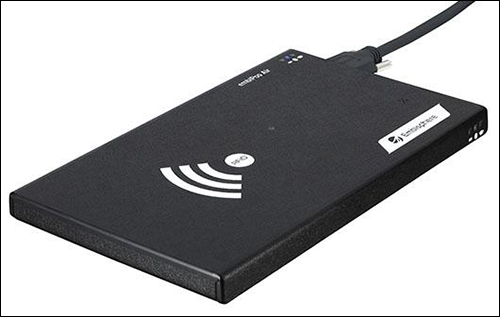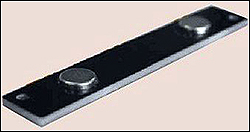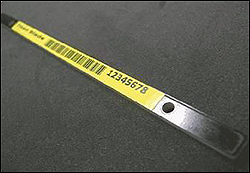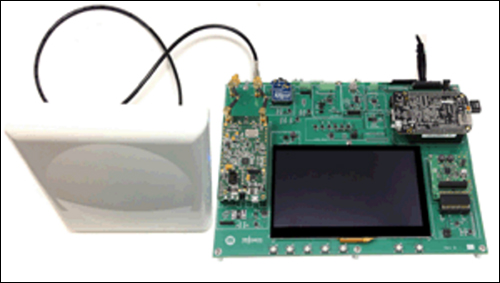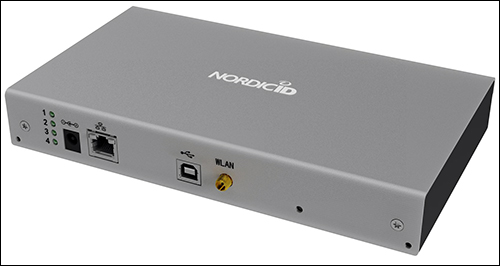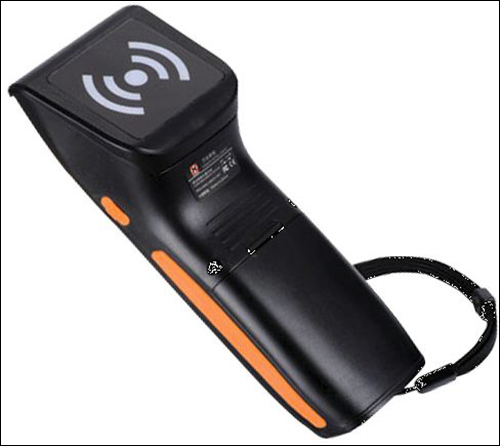The following are news announcements made during the past week by the following organizations:
Embisphere;
GAO RFID;
ON Semiconductor, RFMicron;
Nordic ID;
NXP Semiconductors;
Ams, STMicroelectronics, ARM; and
IDTronic.
Embisphere Unveils Multipurpose UHF RFID Reader for Retailers
Embisphere has announced a new multipurpose RFID reader, known as the embiPos Air. The wall-mountable reader integrates a built-in ultrahigh-frequency (UHF) circular-polarized antenna in a thin, compact shape, the company reports, making it suitable for picking and packing, point-of-sale, fitting-room and shelving applications. According to Embisphere, the device—which supports the EPC Gen 2 and ISO 18000-6C specifications—has already been chosen by several retailers, including sporting goods retailer Decathlon.
The embiPos Air can be connected via a single USB cable to any device—Android, iOS, or Microsoft Windows Phone or Windows—through Bluetooth, with up to a 30-meter (98.4-foot) range. It can be interfaced directly in keyboard emulation mode or via its application programming interface (API). The reader measures 114 millimeters by 189 millimeters by 12 millimeters (4.5 inches by 7.4 inches by 0.5 inch), and weighs 250 grams (0.6 ounce).
GAO RFID Launches New Family of On-Metal RFID Tags
GAO RFID has announced a new family of mount-on-metal ultrahigh-frequency (UHF) EPC Gen 2 RFID tags resistant to extreme temperatures, humidity and impact. All tags in the new family are RoHS-compliant and have an IP68 rating for certified protection from dust and water. These tags can be used for applications requiring the identification, tracking and monitoring of metallic assets, the company reports. GAO offers bar-code printing and RFID encoding for these tags.
The Fastenable Mount-on-Metal tag (model 116035) measures 148 millimeters by 18.2 millimeters by 3.2 millimeters (5.8 inches by 0.7 inch by 0.13 inch) and features two holes for easy mounting with rivets or other fasteners. The tag’s larger size provides a read distance of more than 16 feet (5 meters) when mounted on metal. The Form Factor Mount-on Metal tag (model 116039) is the size of a paperclip and measures 38 millimeters by 10 millimeters by 3.2 millimeters (1.5 inches by 0.4 inch by 0.13 inch), while the ultra-thin tag (model 116040) is the thinnest of GAO’s series of on-metal RFID tags, at only 0.05 inch (1.27 millimeter). The magnetic on-metal tag (model 116036) features two small magnets for easy attachment and removal from metal assets, and offers an on-metal read distance of 13 feet (4 meters). All of these tags are constructed from durable flame-retardant 4 (FR-4) laminate and can endure temperatures of 200 degrees Celsius (392 degrees Fahrenheit) even in oil.
The UHF Gen 2 RFID Razor tag (model 116427) is specially designed for a wide range of applications, such as electronics and asset tracking. It can be read from a distance of up to 6 meters (19.7 feet) on metal and up to 8 meters (26.2 feet) on non-metal surfaces.
Thinner and shorter tags are valuable in environments in which a lower profile is required, according to the company.
ON Semiconductor, RFMicron Intro RFID Sensor Platform for IoT Applications
ON Semiconductor and RFMicron have partnered to develop a plug-and-play development tool designed to speed up the deployment of wireless passive sensor solutions onto any Internet of Things (IoT) cloud platform. The IoT Platform Development Kit, SensorRFGEVK, brings together computing and connectivity modules, the two companies report, in order to facilitate quick and effective deployment of battery-free wireless sensing technology and IoT hardware in locations where power and space constraints are of particular concern.
Each IoT Platform Development Kit incorporates ON Semiconductor’s battery-free wireless sensor tags, which use RFMicron’s Magnus S2 Sensor RFID chip, and can perform temperature, moisture, pressure or proximity sensing functions. The platform also features an ultrahigh-frequency (UHF) RFID reader module with a power rating of 32 decibel-milliwatts (dBm) and a frequency range of 860 to 960 MHz. Localized data processing is performed by the ARM Cortex-A8-based AM335x system-on-chip (SoC). The platform has the capacity to transfer captured data either wirelessly (via WLAN, ZigBee, Z-Wave, UHF Gen 2, etc.) or using a wireline infrastructure (via KNX, CAN, SPI, Ethernet and so forth).
The kit’s accompanying software allows the platform to fit seamless into any supported network, serving as a dedicated node, according to the two companies. Built-in application firmware will assist engineers in implementing more effective IoT-based data-acquisition and -monitoring systems, the companies say, irrespective of their experience level. The kit also includes a system motherboard with an LCD touchscreen, a BeagleBone single-board Linux computer, a wireless communication board, a DC power supply and cable, a directional reader antenna, a coaxial antenna cable, an SD card for system restore, and a USB cable for connecting peripherals to the BeagleBone, as well as five temperature-sensing tags and five moisture-sensing tags.
The kit currently ships without a dedicated pressure sensor. However, ON Semiconductor says it has plans to include one in the near future. Both of the tags that come with the kit can be used for proximity sensing, which is defined in the relationship to the antenna of an RFID interrogator ecosystem and is based on the received signal strength indicator (RSSI) that the tag sends every time it is interrogated. In addition, the new development kit complements ON Semiconductor’s existing wireless sensor, the SPS1M-EVK, which provides a set of tools to test sensor capabilities.
“This IoT Platform Development Kit opens up greater opportunities for IoT-based data-acquisition/monitoring enabling the implementation of wireless sensors quickly and effectively into many applications. Using it, the data from multiple sensors can rapidly be accessed, analyzed and used on multiple backend networks,” said Gary Straker, the VP and general manager of ON Semiconductor’s protection and signal division, in a prepared statement. “As a result of this platform, wireless sensing technology can now be deployed into application scenarios where a mains supply is simply not available or where replacing batteries would be too difficult and costly to undertake. This ground-breaking product will markedly broaden the scope of IoT deployment and this development kit offers a tool that makes evaluating the technology simple for multiple application use cases. Through this wireless sensing technology we will be able to connect what was previously un-connectable.”
The wireless sensor IoT Platform Development Kit, SensorRFGEVK, and the wireless evaluation kit, SPS1M-EVK, are available now at ON Semiconductor’s website or through all franchised distributors.
Nordic ID Releases New Fixed UHF RFID Reader, Antennas
Nordic ID has released its AR52 area reader and three different reader antennas. The new reader is an ultrahigh-frequency (UHF) RFID interrogator suitable for a variety of applications, and the new antenna products are all part of Nordic ID’s Antenna product family. In addition, the company has announced that its NUR application programming interface (API) supports new events functionalities, including location and direction of movement detection, that can be used in its AR55 readers. Nordic ID uses its NUR reader module to make many of its readers.
The AR52 fixed reader is equipped with 16 external antenna ports and has a typical reading speed of 200 tags per second in DRM mode. It supports the EPC Gen2v2 and ISO 18000-63 standards and is 210 millimeters (8.3 inches) in length, 121 millimeters (4.8 inches) in width and 31 millimeters (1.2 inches) in height. The device is designed to be a central point for connecting the antennas, which can be individually controlled and adjusted. The AR52 reader is designed for use cases in which multiple antennas are required, such as locations with metal racks, shelves and intelligent cabinet solutions, the company reports. The intelligent cabinet solutions can be built around the AR52 and external antennas. In the manufacturing sector, for example, an intelligent cabinet solution that enables online reading can improve the quality of monitoring and save time and costs, the firm adds.
“Intelligent shelves and cabinets are an essential part of today’s RFID technology,” said Atte Kaskihalme, Nordic ID’s business area director for logistics and manufacturing, in a prepared statement. “RFID is not just about fixed or handheld readers—customers have needs for different RFID solutions which work more as an entirety than as individual readers. The 16 external antenna ports in one reader make all this a reality, and that’s why we developed Nordic ID AR52.”
Nordic ID’s new antenna products include the FA3030, the GA2525 and the GA1010. The FAA3030 is a flat, thin and form-fitting antenna designed for use in smart shelves, smart cabinets, commissioning and point-of-sale (POS) applications. It is usable on all surfaces, including metal, according to the company. The GA2525 is a general-purpose antenna with standard VESA mounting that can be used, for example, in gate solutions, and it can endure rough outdoor conditions. The GA1010 is a general-purpose, thin-design antenna that blends in well in different environments. According to the company, it provides consistently good reading performance, even when the tags are placed directly on the surface.
The new NUR API-based events functionality, which includes location and direction of movement detection, is designed for use with Nordic ID AR55 readers. The NUR API interface now allows the software application to be informed when a tag has changed its status of visibility, antenna, RSSI, INOUT, position or one of nine sectors. Visibility, antenna, INOUT and RSSI events can be utilized with all Nordic ID NUR-based devices.
According to Kaskihalme, the new features improve the monitoring of item-level location and direction of movement. “This is an important factor in automated inventory and track-and-trace applications. With Nordic ID AR55, we already know where the items are. Now our customers are able to collect behavior data for business applications and build IoT solutions,” he added in the statement.
NXP Unveils NFC RFID Chips for Next-Gen Applications
NXP Semiconductors has announced Near Field Communication (NFC) solutions that it says are designed to drive innovation for embedded systems in smart-home, access-management and home-banking applications.
According to the company, the new NTAG I²C plus, which extends the family of connected tag solutions that combines passive NFC with I²C interfaces, is designed to enable NFC commissioning and simple “tap-to-connect” communications between smart devices and the home network. The new tags deliver increased data-transfer performance, NXP reports, and include advanced features for password protection, full memory-access configuration from both interfaces, and an ECC-based originality signature for protection against cloning. The tag is compliant with the NFC interface ISO/IEC 14443A Part 2 and 3 and NFC Forum Type 2 Tag specifications, providing full interoperability with every NFC-enabled device, the company says. It offers zero-power operation with non-volatile data storage.
The NTAG I²C Explorer Kit is an all-in-one demo kit (OM5569/NT322E, OM5569/NT322ER) that includes a ready-to-use demonstrator, as well as comprehensive evaluation tools for all NTAG I²C plus functionalities that are further complemented by a thorough set of tools, such as an Android Library from the Mifare software development kit (SDK) that allows customers to develop Android apps.
NXP has also introduced the PN7462, an integrated family of single-chip solutions combining a low-power ARM Cortex-M0 microcontroller core, USB capability, and a contact and contactless interface with full NFC support and capabilities. The PN7462 family is suitable for such applications as corporate access, hospitality or home banking, NXP says, as it integrates a myriad of technologies, supports the complete Mifare product portfolio and comes with an NFC Forum and EMVCo 2.5-compliant software library. According to NXP, the PN7462 family features its Dynamic Power Control (DPC) to ensure robust communication even in harsh environments, which can enable quick product development and certification.
The NTAG I²C plus and the PN7462 family, combined with the recently launched PN5180 front end, are an important part of NXP’s strategy to enable the industry to develop and deliver compelling NFC use cases for smarter and more secure connections, NXP explains.
The NTAG I²C plus is available now through all major NXP distributors. The PN7462 family is expected to become available for mass production in April 2016.
Ams, STMicroelectronics Co-develop Solution for Secure NFC Transactions
Ams, a provider of sensors and analog ICs, and global semiconductor manufacturer STMicroelectronics (ST) have announced that ARM is using the companies’ Near Field Communication (NFC) solution to provide secure, high-performance NFC and microcontroller functionality in ARM’s new wearable reference design.
The NFC solution, developed jointly by ST and ams, comprises STMicroelectronics’ ST54E, a system-in-package featuring an NFC controller (NFCC) and a secure element compliant with the GlobalPlatform standard v2.2, as well as ams’ AS39230 NFC analog front end with boostedNFC technology. This NFC system is particularly well suited to very small, battery-powered products, the two companies indicate, such as wearable devices and smartphones.
According to ams and ST, the ams boostedNFC technology overcomes the difficulties that conventional NFC devices face when attempting to operate via a tiny antenna in an environment hostile to RF transmissions, and the ams/ST solution exceeds the EMVCo requirements for RF performance in contactless payments, even when operating through an antenna smaller than 100 square millimeters (0.16 square inch). The ST SiP provides support for critical NFC security standards worldwide, the companies report, ensuring that the ARM mbed Wearable Reference Design can support secure transaction types required in Internet of Things (IoT) applications, including, but not limited to, contactless payments, automatic fare collection and access control. Moreover, the joint solution is designed to achieve very low average power consumption, which can extend battery run-time between charges.
The mbed Wearable Reference Design provides a model that wearable device original equipment manufacturers (OEMs) can replicate to achieve high-performance NFC card emulation. According to ams and ST, it is easy for system designers to work with, since it is supplied with a complete NFC software stack developed by ST. This stack is compatible with ARM’s mbed IoT Device Platform.
In addition, according to the companies, the RF performance of the ams/ST solution ensures robust NFC functioning, even in the most demanding operating environments. The NFC system draws on the unique capabilities of the ams AS39230, the companies say, which implements active load modulation, boosting the NFC front end’s transmission signal, which can be comparable to or exceeding that of a contactless card that will typically have an antenna that is some 40 times larger.
The ST54E is approved for use as an NFC device in card emulation, peer-to-peer and tag reader modes in compliance with the NFC Forum’s standards. It is also suitable for use in applications requiring worldwide certification, including for Common Criteria, EMVCo, and GlobalPlatform, as well as Visa, MasterCard, American Express, Discover and the People’s Bank of China (PBoC). In addition, the security capabilities of the mbed Wearable Reference Design are enhanced by a separate fingerprint reader, which uses an STM32F411 Dynamic Efficient microcontroller from ST, based on the ARM Cortex-M4 core, to perform fingerprint image processing and matching.
IDTronic Announces I-PICK Handheld UHF Reader
IDTronic has announced I-PICK, a new ultrahigh-frequency (UHF) handheld RFID reader compliant with the EPC Gen 2 and ISO 18000-6B/C standards. The I-PICK provides full mobility for long-range UHF tags, the company reports, and is suitable for warehouse, library, retail and asset-tracking applications.
The I-PICK has an integrated Bluetooth interface enabling it to connect to a PC, PDA or mobile device running the Android or Microsoft Windows Mobile, Win CE5.0 and Windows (starting with XP) operating systems. The handheld can be configured for single reads or for multiple reads in inventory mode. The device has vibration, buzzer and LED status indicators, and all collected data is forwarded to a host PC or PDA in real time. It features a light polymer battery designed to provide long stand-by times and maximum mobility, the company says. The new reader measures 180 millimeters by 55 millimeters by 30 millimeters (7.1 inches by 2.2 inches by 1.2 inches) and weighs 250 grams (8.8 ounces).

